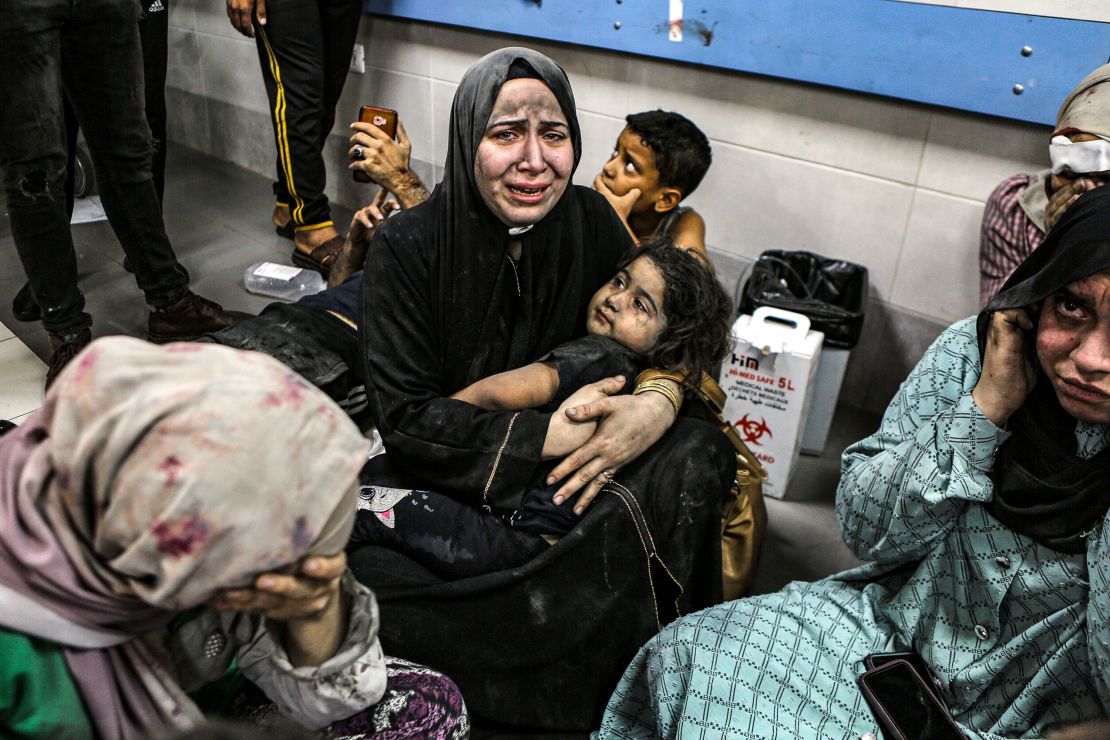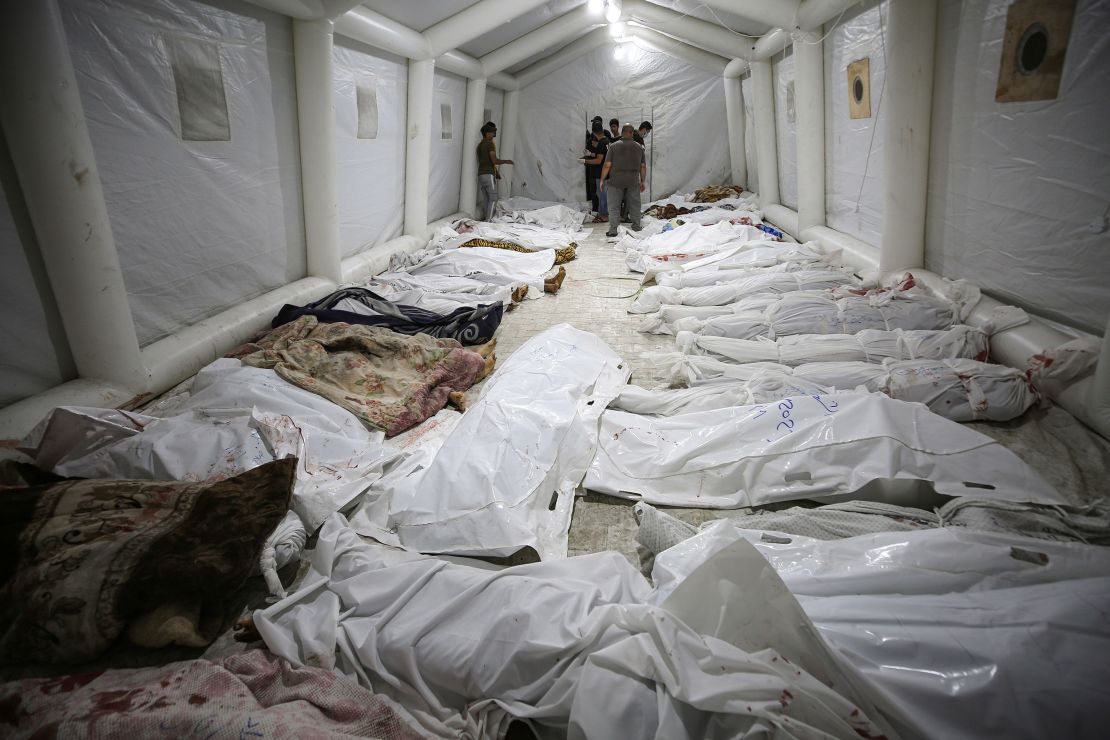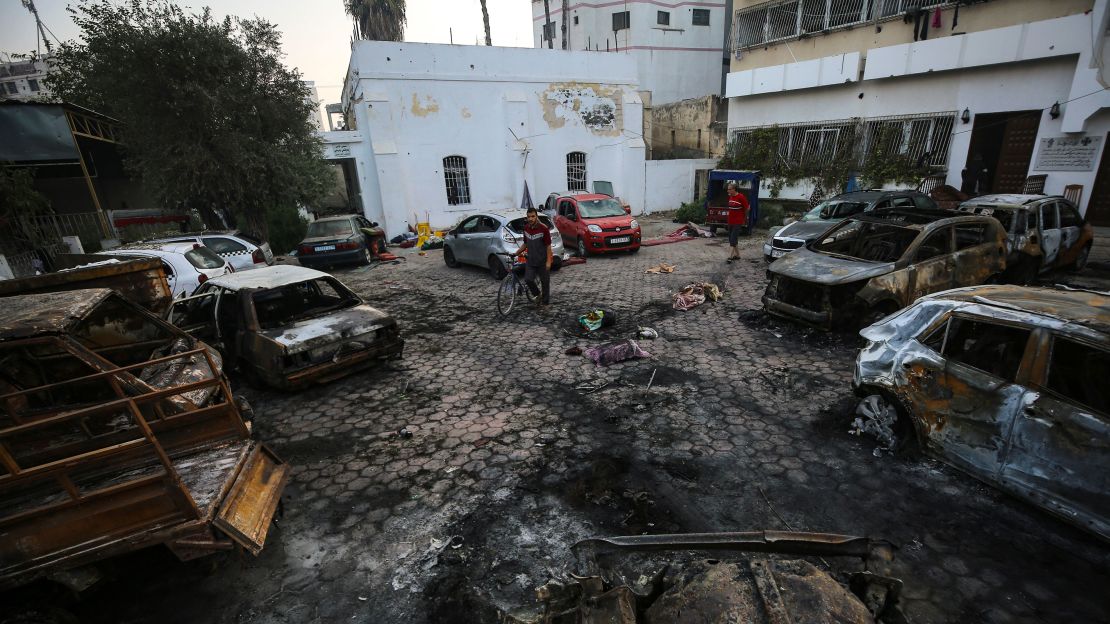Editor’s Note: This story includes analysis of a video of the Al-Ahli Baptist Hospital blast, which was cited by Israel and the US as evidence that a rocket fired from Gaza failed and crashed into the hospital complex. Since this article was first published, CNN reviewed several more videos and determined that the projectile pictured in the footage was launched from Israel and is unlikely to be connected to the hospital explosion. However, that revelation does not alter CNN’s ultimate findings – that while no evidence can be conclusive, the balance of evidence suggests the explosion was not the result of an Israeli airstrike and was likely caused by a malfunctioning rocket. Read our new analysis here. The story below has been updated.
In the days since a blast ripped through the packed Al-Ahli Baptist Hospital in Gaza City, killing hundreds of Palestinians, dueling claims between Palestinian militants and the Israeli government over culpability are still raging. But forensic analysis of publicly available imagery and footage has begun to offer some clues as to what caused the explosion.
CNN has reviewed dozens of videos posted on social media, aired on live broadcasts and filmed by a freelance journalist working for CNN in Gaza, as well as satellite imagery, to piece together what happened in as much detail as possible.
Without the ability to access the site and gather evidence from the ground, no conclusion can be definitive. But CNN’s analysis suggests that a rocket launched from within Gaza broke up midair, and that the blast at the hospital was the result of part of the rocket landing at the hospital complex.
Weapons and explosive experts with decades of experience assessing bomb damage, who reviewed the visual evidence, told CNN they believe this to be the most likely scenario – although they caution the absence of munition remnants or shrapnel from the scene made it difficult to be sure. All agreed that the available evidence of the damage at the site was not consistent with an Israeli airstrike.
Israel says that a “misfired” rocket by militant group Islamic Jihad caused the blast, a claim that US President Joe Biden said on Wednesday is backed up by US intelligence. A spokesperson for the National Security Council later said that analysis of overhead imagery, intercepts and open-source information suggested that Israel is “not responsible.”
Palestinian officials and several Arab leaders nevertheless accuse Israel of hitting the hospital amid its ongoing airstrikes in Gaza. Islamic Jihad (or PIJ) – a rival group to Hamas – has denied responsibility.

The Israel-Hamas war has triggered a wave of misleading content and false claims online. That misinformation, coupled with the polarizing nature of the conflict, has made it difficult to sort fact from fiction.
In the past few days, a number of outlets have published investigations into the Al-Ahli Hospital blast. Some have reached diametrically different conclusions, reflecting the challenges of doing such analysis remotely.
But as more information surfaces, CNN’s investigation – which includes a review of nighttime video of the explosion, and horrifying images of those injured and killed inside the hospital complex – is an effort to shed light on details of the blast beyond what Israel and the US have produced publicly.
A flash of light in the dark
On the evening of October 17, a barrage of rocket fire illuminated the night sky over Gaza before the deadly blast, according to videos analyzed by CNN.
An Al Jazeera camera, located in western Gaza and facing east, was broadcasting live on the channel at 6:59 p.m. local time on Tuesday night, according to the timestamp. The footage shows a projectile traveling in an upwards trajectory before reversing direction and exploding, leaving a brief, bright streak of light in the night sky above Gaza City. Just moments later, two blasts are visible on the ground, including one at Al-Ahli Baptist Hospital.
The Israeli and US governments cited the Al Jazeera footage as part of their assessments of the explosion at Al-Ahli, suggesting that it showed the moment a rocket fired from Gaza failed mid-air and crashed into the hospital grounds.
A previous version of this story had drawn a similar conclusion, that the video seemed to capture an errant rocket likely fired from Gaza, but CNN could not independently confirm whether the projectile was linked to the hospital blast.
But after analyzing additional videos, CNN has been able to construct a more complete picture. Multiple camera angles show that the projectile captured in the Al Jazeera broadcast was likely fired from inside Israel, not from Gaza, and unlikely to have any connection to the explosion at Al-Ahli, miles away.
Open-source researchers @ArchieIrving2 and @OAlexanderDK on X, formerly known as Twitter, were the first to triangulate the footage and geolocate the likely launch site to Israel. The New York Times and The Washington Post also reached the same conclusion in recent reports.
Responding to a request for comment on the analysis of the Al Jazeera footage, both the IDF and the Office of the Director of National Intelligence, which produced the US government’s assessment of the hospital blast, told CNN that they had drawn on multiple sources to reach their determination that a failed rocket launched by Palestinian militants caused the hospital blast.
Several weapons experts originally told CNN that the Al Jazeera video appeared to show a rocket burning out in the sky before crashing into the hospital grounds, but that they could not say with certainty that the two incidents were linked – due to the challenges of calculating the trajectory of a rocket that had failed or changed course mid-flight.
By triangulating several videos, CNN was able to determine the rocket was likely fired near the Israeli town of Nahal Oz within proximity of an Israeli military site, which is known to have an Iron Dome defense system. CNN could not independently assess whether what is visible in the video is in fact an Iron Dome interceptor missile. The IDF did not respond to CNN’s request for comment about whether the Iron Dome was used to intercept a rocket fired from Gaza on the evening of October 17, but told The Washington Post that Israel did not make any interceptions around that time.
At 7 p.m., Hamas’ military wing, the Al-Qassam Brigades, posted on its Telegram channel that it had bombarded Ashdod, a coastal Israeli city north of Gaza, with “a barrage of rockets.” A few minutes later, PIJ said on Telegram that its armed wing, Al-Quds Brigades, had launched strikes on Tel Aviv in response to the “enemy’s massacre of civilians.”
Another nighttime video of the blast, which appears to have been filmed on a mobile phone from a balcony and was also geolocated by CNN, captures a whooshing sound before the sky lights up and a large explosion erupts.
Two weapons experts who reviewed the footage for CNN said that the sound in the video was not consistent with that of a high-grade military explosive, such as a bomb or shell. Both said that it was not possible to form any definitive conclusions from the audio in the clip, caveating that the mobile phone could have affected the reliability of the sound.
A leading US acoustic expert, who did not have permission to speak publicly from their university, analyzed the sound waveform from the video and concluded that, while there were changes in the sound frequency, indicating that the object was in motion, there was no directional information that could be gleaned from it.
Panic and carnage
Inside the hospital, the sound was deafening. Dr. Fadel Na’eem, head of the orthopedic department, said he was performing surgery when the blast sounded through the hospital. He said panic ensued as staff members ran into the operating room screaming for help and reporting multiple casualties.
“I just finished one surgery and suddenly we heard a big explosion,” Dr. Na’eem told CNN in a recorded video. “We thought it’s outside the hospital because we never thought that they would bomb the hospital.”
After he left the operating theater, Dr. Na’eem said he found an overwhelming scene. “The medical team scrambled to tend to the wounded and dying, but the magnitude of the devastation was overwhelming.”
Dr. Na’eem said that it wasn’t the first time the hospital had been hit. On October 14, three days earlier, he said that two missiles had struck the building, and that the Israeli military had not called to warn them.
“We thought it was by mistake. And the day after [the Israelis] called the medical director of the hospital and told them, ‘We warned you yesterday, why are you still working? You have to evacuate the hospital,” Dr. Na’eem said, adding that many people and patients had fled before the blast, afraid that the hospital would be hit again.
CNN could not independently verify the details of the October 14 attack described by Dr. Na’eem and has reached out to the IDF for comment. The IDF has said it does not target hospitals, though the UN and Doctors Without Borders say Israeli airstrikes have hit medical facilities, including hospitals and ambulances.
While it is difficult to independently confirm how many people died in the blast, the bloodshed could be seen in images from the aftermath shared on social media. In photos and videos, young children covered in dust are rushed to be treated for their wounds. Other bodies are seen lifeless on the ground.
One local volunteer who did not give his name described the gruesome aftermath of the blast at Al-Ahli Baptist Hospital, saying that he arrived at 8 a.m. and helped to gather the remains of people killed there.
“We gathered six bags filled with pieces of the dead bodies – pieces,” he said. “The eldest we gathered remains for was maybe eight or nine years old. Hands, feet, fingers, I have here half a body in the bag. What were they doing, what did they do. None of them even had a toothbrush let alone a weapon.”

A freelance journalist working for CNN in Gaza went to the scene the following day, interviewing eyewitnesses and filming the blast radius in detail, capturing the impact crater, which was about 3x3 feet wide and one foot deep. Some debris and damage were visible in the wider area, including burned out cars, pockmarked buildings and blown out windows.
Analyzing the aftermath
Eight weapons and explosive experts who reviewed CNN’s footage of the scene agreed that the small crater size and widespread surface damage were inconsistent with an aircraft bomb, which would have destroyed most things at the point of impact. Many said that the evidence pointed to the possibility that a rocket was responsible for the explosion.
Marc Garlasco, a former defense intelligence analyst and UN war crimes investigator with decades of experience assessing bomb damage, said that whatever hit the hospital in Gaza was not an airstrike. “Even the smallest JDAM [joint direct attack munition] leaves a 3m crater,” he told CNN, referring to a guided air-to-ground system that is part of the Israeli weapons stockpile provided by the US.
Chris Cobb-Smith, a British weapons expert who was part of an Amnesty International team investigating weapons used by Israel during the Gaza War in 2009, told CNN the size of the crater led him to rule out a heavy, air-dropped bomb. “The type of crater that I’ve seen on the imagery so far, isn’t large enough to be the type of bomb that we’ve that we’ve seen dropped in, in the region on many occasions,” he said.
An arms investigator said the impact was “more characteristic of a rocket strike with burn marks from leftover rocket fuel or propellant,” and not something you would see from “a typical artillery projectile.”
Cobb-Smith said that the conflagration following the blast was inconsistent with an artillery strike, but that it could not be entirely ruled out.
Others said the damage seen at the site – specifically to the burned-out cars – did not seem to suggest that the explosion was the result of an airburst fuze, which is when a shell explodes in the air before hitting the ground, or artillery fire. Patrick Senft, a research coordinator at Armament Research Services (ARES), said that he would have expected the roofs of the cars to show significant fragmentation damage and the impact site to be deeper, in that case.
“For a 152 / 155 mm artillery projectile with a point detonation fuze (one that initiates the explosion upon hitting the ground) I would expect a crater of about 1.5m deep and 5m wide. The crater here seems substantially smaller,” Senft said.
An explosives specialist, who is currently working in law enforcement and was not authorized to speak to the press, said it’s likely that the shrapnel from the projectile ignited the fuel and flammable liquid in the cars, which is why the fireball was so big. These kinds of explosions generate a shockwave that is particularly deadly to children and the frail.
The same specialist, who has spent decades conducting forensic investigations in conflict zones around the world, also said the damage at the crater site, and at the scene, was not congruent with damage normally seen at an artillery shelling site.
Without knowing what kind of projectile produced the crater, it is difficult to draw conclusions about the direction that it came from. However, the debris and ground markings point to a few possibilities.
There are dark patches on the ground fanning out in a southwesterly direction from the crater. The trees behind it are scorched and a lamppost is entirely knocked over. In contrast, the trees on the other side of the crater are still intact, even with green leaves.
This would be consistent with a rocket approaching from the southwest, as rockets scorch and damage the earth on approach to the ground. If the munition was artillery, however, these markings could indicate it came in from the northeast, spewing debris to the southwest. But if the projectile malfunctioned and broke apart in the air, as CNN’s analysis suggests, the direction of impact reflected by the crater would not be a reliable finding.
Contrasting narratives
Israel has presented two contrasting narratives on which direction the alleged Hamas rocket flew in from.
In an audio recording released by Israeli officials, which they say is Hamas militants discussing the blast and attributing it to a rocket launched by Islamic Jihad (or PIJ), a “cemetery behind the hospital” is referenced as the launch site. CNN analyzed satellite imagery for the days prior to the attack and found no apparent evidence of a rocket launch site there. CNN could not verify the authenticity of the audio intercept.
The IDF also published a map indicating the rocket had been launched several kilometers away, from a southwesterly direction, showing the trajectory towards the hospital. The map is not detailed but it indicates a rocket launch site that matches a location CNN has previously identified as a Hamas training site. Satellite imagery from this site indicates some activity in the days prior to the hospital blast but CNN cannot determine whether a rocket was launched from there and has also asked the IDF for more details about its map.
Until an independent investigation is allowed on the ground and evidence collected from the site the prospect of determining who was behind the blast is remote.

“An awful lot will depend on what remnants are found in the wreckage,” Chris Cobb-Smith told CNN. “We can analyze footage, we can listen to audio, but the definitive answer will come from the person or the team that go in and rummage around the rubble and come up with remnants of the munition itself.” Getting independent experts there will prove challenging given the war still raging, and Israel’s looming ground offensive in Gaza.
Marc Garlasco, the former defense intelligence analyst and UN war crimes investigator, says there are signs of a lack of evidence at the Al-Ahli hospital site.
“When I investigate a site of a potential war crime the first thing I do is locate and identify parts of the weapon. The weapon tells you who did it and how. I’ve never seen such a lack of physical evidence for a weapon at a site. Ever. There’s always a piece of a bomb after the fact. In 20 years of investigating war crimes this is the first time I haven’t seen any weapon remnants. And I’ve worked three wars in Gaza.”
Footage CNN collected the day after the blast shows a large number of people traversing the site. The risk that amid the chaos and panic of war, the evidence will be lost or tampered with, is high. Even before this conflict, accessing sites was challenging for independent investigators. Cobb-Smith has investigated in Gaza before.
“The local authorities did not give me free access to the area or were very unhappy that I was trying to investigate something that had clearly gone wrong from their point of view.”
CNN’s Teele Rebane, Eve Brennan, Yong Xiong and Alex Marquardt contributed to this report.
Visual editing by Henrik Pettersson, Marco Chacón, Carlotta Dotto, Emmalee Reed and Victoria Fleischer.





